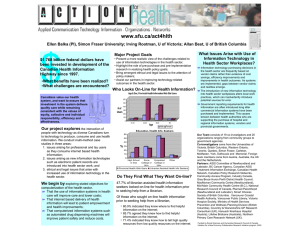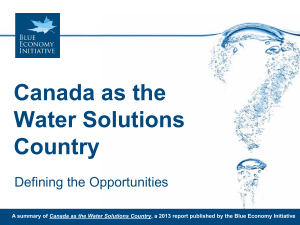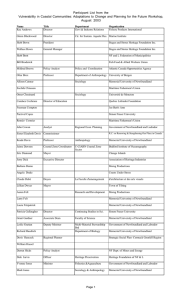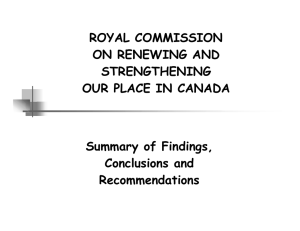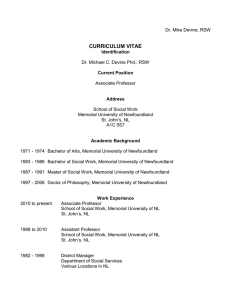Information Highway since 1997. Yet few resources have been directed... not investment in Canada’s Health Information Highway are achieving desired... The Problem:
advertisement
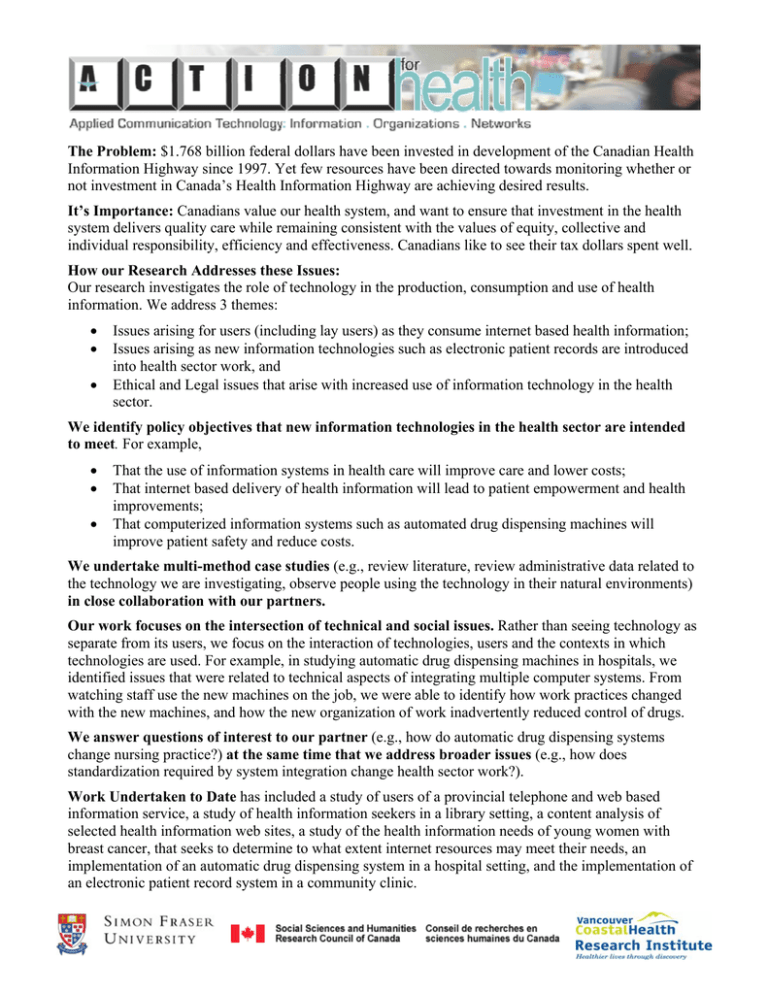
The Problem: $1.768 billion federal dollars have been invested in development of the Canadian Health Information Highway since 1997. Yet few resources have been directed towards monitoring whether or not investment in Canada’s Health Information Highway are achieving desired results. It’s Importance: Canadians value our health system, and want to ensure that investment in the health system delivers quality care while remaining consistent with the values of equity, collective and individual responsibility, efficiency and effectiveness. Canadians like to see their tax dollars spent well. How our Research Addresses these Issues: Our research investigates the role of technology in the production, consumption and use of health information. We address 3 themes: • • • Issues arising for users (including lay users) as they consume internet based health information; Issues arising as new information technologies such as electronic patient records are introduced into health sector work, and Ethical and Legal issues that arise with increased use of information technology in the health sector. We identify policy objectives that new information technologies in the health sector are intended to meet. For example, • • • That the use of information systems in health care will improve care and lower costs; That internet based delivery of health information will lead to patient empowerment and health improvements; That computerized information systems such as automated drug dispensing machines will improve patient safety and reduce costs. We undertake multi-method case studies (e.g., review literature, review administrative data related to the technology we are investigating, observe people using the technology in their natural environments) in close collaboration with our partners. Our work focuses on the intersection of technical and social issues. Rather than seeing technology as separate from its users, we focus on the interaction of technologies, users and the contexts in which technologies are used. For example, in studying automatic drug dispensing machines in hospitals, we identified issues that were related to technical aspects of integrating multiple computer systems. From watching staff use the new machines on the job, we were able to identify how work practices changed with the new machines, and how the new organization of work inadvertently reduced control of drugs. We answer questions of interest to our partner (e.g., how do automatic drug dispensing systems change nursing practice?) at the same time that we address broader issues (e.g., how does standardization required by system integration change health sector work?). Work Undertaken to Date has included a study of users of a provincial telephone and web based information service, a study of health information seekers in a library setting, a content analysis of selected health information web sites, a study of the health information needs of young women with breast cancer, that seeks to determine to what extent internet resources may meet their needs, an implementation of an automatic drug dispensing system in a hospital setting, and the implementation of an electronic patient record system in a community clinic. Findings • • • • • • • • • Consumption of Internet Based Health Information Literacy organizations recommend that written information intended for public use be written at a grade 6 reading level. Government health information web sites studied (which included a provincial and federal web sites) were written at a level that requires between 15 and 23 years of education. None of the sites offered information consumers access to an on-line glossary. Only 1 of the sites studied used a font size larger than 10 pt, widely considered to be at a low minimum for anyone who is visually compromised (e.g., requires eyeglasses to read). Although accessibility of information contained on health web sites (e.g., use of plain language) was considered important by information providers, in no cases were providers required to deliver information in plain language. Key informants suggested that plain language was not a deciding factor in content selection, and that it was often too costly to implement. Our data indicate that there is a weak association between level of education and use of the internet to consume health information prior to seeking assistance from a librarian—higher levels of education are associated with greater use of the internet for health information seeking. Homeowners are significantly more likely than renters to seek on-line health information after consulting a librarian. Use of Information Technology in Health Sector Workplaces Information technology purchasing decisions in the health sector are frequently based on vendor claims rather than evidence of cost savings, efficiency improvements and improvements in health outcomes. As systems are implemented, gaps between vendor claims and realities emerge. The introduction of new information technology into health sector workplaces alters local work practices, which can inadvertently introduce potential sources for error. Government reporting requirements for health information are often introduced long after commercial information systems have been purchased and implemented. This causes tension between health authorities who are supporting the purchase of hospital and regional information systems, vendors and provincial governments. Major Project Goals: Our research will present a more realistic perspective of the challenges associated with increased use of information technologies in the health sector. It highlights the role that pre-purchase and pre-implementation research can play in helping to realize stated policy goals associated with use of technology in the health sector. It will bring emergent ethical and legal issues to the attention of policy makers, assist our partners in determining whether or not the goals they are pursuing with the aid of information technology are being met, and will offer suggestions about improving technology-related outcomes in the health sector. Partners: Aids Committee of Newfoundland and Labrador, BC Cancer Agency, Canadian Aids Treatment Information Exchange, Canadian Health Network, Canadian Policy Research Networks , Community Access Program, Industry Canada, Grey Bruce Huron Perth District Health Council, MacMorran Community Centre (Newfoundland), Mid-Main Community Health Centre (B.C.), National Research Council of Canada, Planned Parenthood (Newfoundland and Labrador), Smart Choices Society of British Columbia , Vancouver Coastal Health Authority, Vancouver Public Library, Victoria Hospice Society, Ministry of Health Services, Prevention and Wellness Planning Division (British Columbia), , Coventry & Warwickshire GP Research Consortium (UK), Hanusch Kranhaus Hospital (Austria), Lifeline Brisbane (Australia), Northern Primary Care Research Network (UK). Ellen Balka, Ph.D., Principle Investigator School of Communication, 8888 University Way, Simon Fraser University, Burnaby, B.C. V5A 1S6 Phone: (604) 725-2756 Web: www.sfu.ca/act4hlth E-mail: ellenb@sfu.ca

